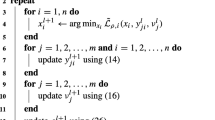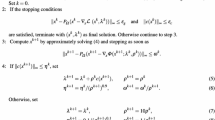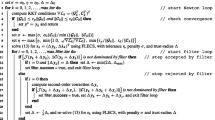Abstract
Analytical target cascading is a method for design optimization of hierarchical, multilevel systems. A quadratic penalty relaxation of the system consistency constraints is used to ensure subproblem feasibility. A typical nested solution strategy consists of inner and outer loops. In the inner loop, the coupled subproblems are solved iteratively with fixed penalty weights. After convergence of the inner loop, the outer loop updates the penalty weights. The article presents an augmented Lagrangian relaxation that reduces the computational cost associated with ill-conditioning of subproblems in the inner loop. The alternating direction method of multipliers is used to update penalty parameters after a single inner loop iteration, so that subproblems need to be solved only once. Experiments with four examples show that computational costs are decreased by orders of magnitude ranging between 10 and 1000.
Similar content being viewed by others
References
Alexandrov NM, Lewis RM (1999) Comparative properties of collaborative optimization and other approaches to MDO. In: ASMO UK/ISSMO conference on engineering design optimization. MCB Press
Alexandrov NM, Lewis RM (2002) Analytical and computational aspects of collaborative optimization for multidisciplinary design. AIAA J 40:301–309
Allison JT, Kokkolaros M, Zawislak M, Papalambros PY (2005) On the use of analytical target cascading and colloborative optimization for complex system design. In: Proceedings of the 6th world congress on structural and multidisciplinary optimization, Rio de Janeiro, Brazil
Bertsekas DP (2003) Nonlinear programming, 2nd edn., 2nd printing. Athena Scientific, Belmont, MA
Bertsekas DP, Tsitsiklis JN (1989) Parallel and distributed computation. Prentice-Hall, Englewood Cliffs, NJ
Braun RD (1996) Collaborative optimization: an architecture for Lagre-scale distributed design. PhD Thesis, Stanford University
Braun RD, Moore AA, Kroo IM (1997) Collaborative approach to launch vehicle design. J Spacecr Rockets 34:478–486
Holmström K, Göran AO, Edvall MM (2004) User's guide for TOMLAB 4.2. Tomlab Optimization Inc., San Diego, CA (http://tomlab.biz)
Kim HM (2001) Target cascading in optimal system design. PhD Thesis, University of Michigan
Kim HM, Kokkolaras M, Louca LS, Delagrammatikas GJ, Michelena NF, Filipi ZS, Papalambros PY, Stein JL, Assanis DN (2002) Target cascading in automotive vehicle design: a class 6 truck study. Int J Veh Des 29:199–225
Kim HM, Michelena NF, Papalambros PY, Jiang T (2003) Target cascading in optimal system design. ASME J Mech Des 125:475–480
Lasdon LS (1970) Optimization theory for large systems. Macmillan Company, New York
Lassiter JB, Wiecek MM, Andrighetti KR (2005) Lagrangian coordination and analytical target cascading: solving ATC-decomposed problems with Lagrangian duality. Opt Eng 67:361–381
Mathworks (2002) Matlab reference guide, version 6. Mathworks Inc., Natick, MA (http://www.mathworks.com)
Michalek JJ, Papalambros PY (2005a) An efficient weighting update method to achieve acceptable inconsistency deviation in analytical target cascading. ASME J Mech Des 127:206–214
Michalek JJ, Papalambros PY (2005b) Weights, norms, and notation in analytical target cascading. ASME J Mech Des 127:499–501
Michelena NF, Park H, Papalambros PY (2003) Convergence properties of analytical target cascading. AIAA J 41:897–905
Ruszczynski A (1995) On convergence of an augmented Lagrangian decomposition for sparse convex optimization. Math Oper Res 20:634–656
Tosserams S (2004) Analytical target cascading: convergence improvement by subproblem post-optimality sensitivities. MSc thesis, Eindhoven University of Technology, The Netherlands, SE-420389
Tzevelekos N, Kokkolaras M, Papalambros PY, Hulshof MF, Etman LFP, Rooda JE (2003) An empirical local convergence study of alternative coordination schemes in analytical target cascading. In: Proceedings of the 5th world congress on structural and multidisciplinary optimization, Lido di Jesolo, Venice, Italy
Author information
Authors and Affiliations
Corresponding author
Rights and permissions
About this article
Cite this article
Tosserams, S., Etman, L.F.P., Papalambros, P.Y. et al. An augmented Lagrangian relaxation for analytical target cascading using the alternating direction method of multipliers. Struct Multidisc Optim 31, 176–189 (2006). https://doi.org/10.1007/s00158-005-0579-0
Received:
Revised:
Published:
Issue Date:
DOI: https://doi.org/10.1007/s00158-005-0579-0




